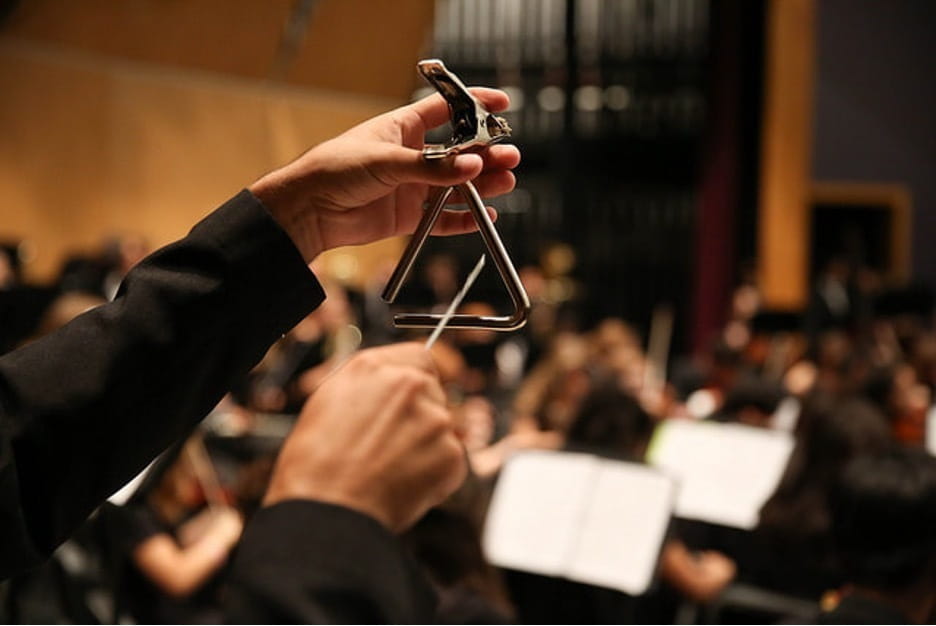It’s an iconic percussion instrument known for its distinctive sound. You’ve heard it in popular songs, holiday concerts, and probably even recognize it from cartoons when a light bulb appears to show a bright idea—ting!
That’s the triangle. Simple sound. Simple name. But it’s really not simple at all...
In fact, it's incredibly complex. And it’s this quality that gives it the power to be heard through just about anything, making it one of the most popularly used instruments, spanning almost every musical genre and culture.
Here’s the thing...
In a world where capturing attention is a constant battle, the triangle can serve as a powerful example for brands looking to stand out and rise above the noise.
Small but Mighty
Across the world, the triangle’s popularity is undeniable. While there are far too many to list here, take a moment and listen to this small sampling of some of the more widely known examples:
- William Tell Overture Finale by Rossini
- Stand By Me by Ben E. King
- Señorita by Justin Timberlake
- Yeah! by Usher
What’s so incredible about each of these is that no matter how loud the other instruments are, the triangle is always heard with perfect clarity. It’s not difficult to pick out. It's immediately recognizable. You hear that ting, and there’s no question.
But how does it cut through so effortlessly?
The secret is what’s behind the ting. What you’re really hearing is an intricate blend of multiple frequencies. It’s this complexity that makes the triangle an instrument of indefinite pitch.
In other words, the sound is so radically different, so unique—it can never blend in. Because of this, the triangle has the power to be heard through just about anything.
The Fight to be Heard
In this information-rich and time-poor society, earning the attention of your intended audience can feel overwhelming. There’s a lot of noise out there, and people have become experts at tuning things out. Today, it’s more than a fight against your competitors—it's a fight simply to be heard.
In his book ZAG, Marty Neumeier writes that if brands really want to stand out, traditional differentiation won’t cut it. The lowest price, fastest speed, latest features... all have too few competitive advantages. To effectively stand out, brands need to leverage what makes them unique. Brands need to be radically different.
Of course, no one has ever described the triangle as radical. But leveraging a radical difference doesn’t necessarily have to mean taking a radical approach. In the right context, embracing conservative brand qualities could be the key to standing out.
It just so happens that’s exactly what one craft brewing company capitalized on with their “Never Trend” campaign.
Brands that Ring True
Bell’s Brewery doesn’t just stand out from competitors. It rises above the noise. In a market oversaturated with ridiculous brand names and extreme package designs, instead of trying to appear equally extreme, instead of blending in, Bell’s decided to lean even harder into their established brand.
With headlines like, “Not New. Not improved.” their simple message resounds with perfect clarity, cutting through the extra hype of competitors.

That’s Bell’s. Simple brand. Simple message. But it’s really not simple at all...
In fact, it’s incredibly complex. Behind this creative application is a thoughtful, well-informed brand strategy. The message is simple: tradition wins over trends. But the secret is what’s behind the message—what's behind the ting.
What you’re really seeing is a complex blend of creatively repurposed brand attributes. Compared to others, Bell’s brand could be seen as traditional, reliable, and almost old-fashioned. In isolation none of these qualities are impressive. But in the larger context, those same seemingly boring attributes are transformed into a radical difference.
In a world of exhaustingly trendy beverages, Bell’s provides a refreshingly reliable, unchanging, consistent product. It’s a great value prop. It’s a radical difference. And it might have the power to be heard through just about anything.
Find Your Ting
Truth be told, leveraging what makes your brand unique is easier said than done. In theory, it makes perfect sense: identify your radical difference and leverage it to full potential. In practice, it’s much more complicated.
Here’s the Good News:
It’s very likely your radical difference is hiding in plain sight. Brand-level insights and unique attributes are usually embedded into mission statements, sales training, and even brand guidelines. All are great places to start.
But if you can’t find it in the usual places, the next option is organizing a brand strategy workshop. This can be successful using exclusively internal resources, but many times an outside perspective can provide great objectivity and help combat the idiom, “It’s hard to read the label from inside the bottle.”
Simple is Complex.
Think back to what's behind the ting. It sounds simple, but it’s built on a blend of multiple frequencies. In the same way the triangle’s complexity allows it to be heard in any musical setting, brands that embrace their radical difference have the greatest potential to rise above the noise.
Because in a market oversaturated with options, it’s not about being the loudest. It’s about being the most unique—like the triangle.
Looking for Sound Advice?
If you’d like to learn more about how your brand can stand above the rest, please reach out to us here at Liquid! We love helping clients find creative ways to resonate with their customers.

